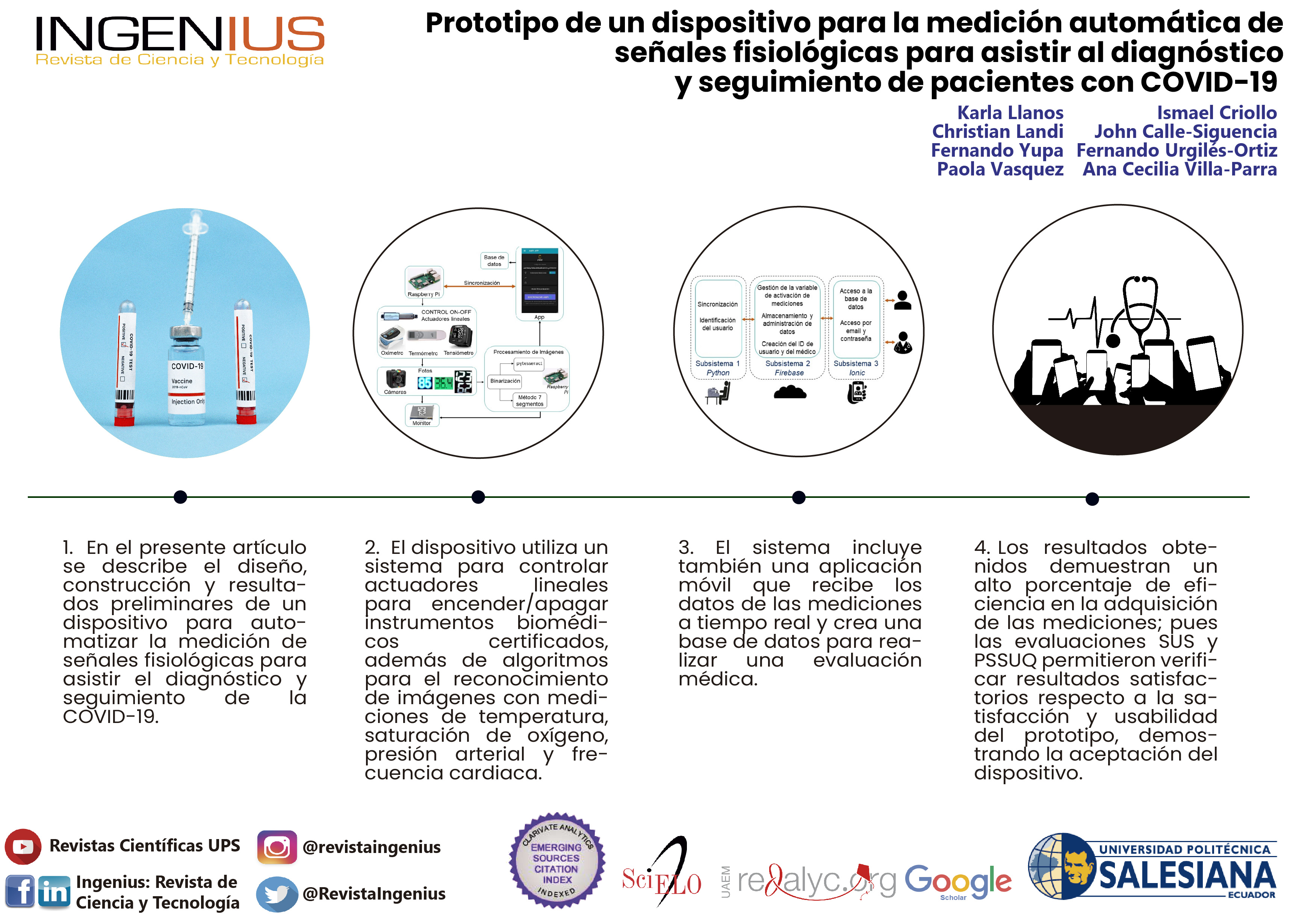Evaluation of AIoT performance in Cloud and Edge computational models for mask detection
Main Article Content
Abstract
Keywords
AIoT, COVID-19, computación en la nube, computación de borde, detección de máscara facial, YOLO AIoT, COVID-19, Cloud Computing, Edge Computing, Face mask detection, YOLO
References
[2] WHO, “Listings of WHO’s response to COVID-19,” World Health Organization. [Online]. Available: https://bit.ly/3mAZ6LH
[3] ——, “Vías de transmisión del virus de la COVID-19: Repercusiones para las recomendaciones relativas a las precauciones en materia de prevención y control de las infecciones.” [Online]. Available: https://bit.ly/3epu4Sq
[4] OMS, “Who coronavirus (COVID-19) dashboard,” 2021. [Online]. Available: https://bit.ly/3mDAO3r
[5] OPS, “Vacunas contra la COVID-19,” 2020. [Online]. Available: https://bit.ly/3z0JGFs
[6] H. Ritchie, E. Mathieu, L. Rodés-Guirao, C. Appel, C. Giattino, E. Ortiz-Ospina, J. Hasell, B. Macdonald, D. Beltekian, M. Roser, and et al., “Coronavirus (COVID-19) vaccinations - statistics and research,” 2020. [Online]. Available: https://bit.ly/3sEmtro
[7] C. Costa and C. Tombesi, “COVID-19: Cuánto tiempo se demoró en encontrar la vacuna para algunas enfermedades (y por qué este coronavirus es un caso histórico),” 2020. [Online]. Available: https://bbc.in/3pEV0Eh
[8] “Comparative research grant,” Anthropology News, vol. 36, no. 8, pp. 43–43, 1995. [Online]. Available: https://doi.org/10.1111/an.1995.36.8.43.1
[9] S. S. Bibak Sareshkeh, E. Magli, and P. Dal Zovo, “Combined ict technologies for supervision of complex operations in resilient communities,” Master’s thesis, 2020. [Online]. Available: https://bit.ly/3HaioPE
[10] I. Santos-González, A. Rivero-García, J. Molina-Gil, and P. Caballero-Gil, Implementation and Analysis of Real-Time Streaming Protocols, vol. 17, no. 4, 2017. [Online]. Available: https://doi.org/10.3390/s17040846
[11] A. Nurrohman and M. Abdurohman, “High performance streaming based on H264 and real time messaging protocol (RTMP),” in 2018 6th International Conference on Information and Communication Technology (ICoICT), 2018, pp. 174–177. [Online]. Available: https://doi.org/10.1109/ICoICT.2018.8528770
[12] S. Basu, “What are video streaming codecs & container formats: Muvi live server,” 2020. [Online]. Available: https://bit.ly/3ErJPCZ
[13] J. S. Katz, “Aiot: Thoughts on artificial intelligence and the internet of things,” IEEE Internet if Things, 2019. [Online]. Available: https://bit.ly/3sBwGEZ
[14] J. Redmon and A. Farhadi, “Yolov3: An incremental improvement,” ArXiv, vol. abs/1804.02767, 2018. [Online]. Available: https://bit.ly/3psJLyp
[15] A. M. Porcelli, “La inteligencia artificial y la robótica: sus dilemas sociales, éticos y jurídicos,” Derecho global. Estudios sobre derecho y justicia, vol. 6, pp. 49–105, 2020. [Online]. Available: https://doi.org/10.32870/dgedj.v6i16.286
[16] X. Jiang, T. Gao, Z. Zhu, and Y. Zhao, “Real-time face mask detection method based on YOLOv3,” Electronics, vol. 10, no. 7, p. 837, 2021. [Online]. Available: https://doi.org/10.3390/electronics10070837
[17] S. Sethi, M. Kathuria, and T. Kaushik, “Face mask detection using deep learning: An approach to reduce risk of coronavirus spread,” Journal of Biomedical Informatics, vol. 120, p. 103848, 2021. [Online]. Available: https://doi.org/10.1016/j.jbi.2021.103848
[18] D. González Dondo, J. A. Redolfi, R. G. Araguás, and D. García, “Application of deep-learning methods to real time face mask detection,” IEEE Latin America Transactions, vol. 19, no. 6, pp. 994–1001, 2021. [Online]. Available: https://bit.ly/3pw7DkM
[19] S. Sethi, M. Kathuria, and T. Kaushik, “A real-time integrated face mask detector to curtail spread of coronavirus,” Computer Modeling in Engineering & Sciences, vol. 127, no. 2, pp. 389–409, 2021. [Online]. Available: https://doi.org/10.32604/cmes.2021.014478
[20] I. Vich, “Medical masks dataset images tfrecords,” Kaggle, 2020. [Online]. Available: https://bit.ly/3er0tb8
[21] S. Ge, J. Li, Q. Ye, and Z. Luo, “MAFA,” 2018. [Online]. Available: https://bit.ly/3FBC52o
[22] S. Yadav and S. Shukla, “Analysis of k-Fold Cross-validation over hold-out validation on colossal datasets for quality classification,” in 2016 IEEE 6th International Conference on Advanced Computing (IACC), 2016, pp. 78–83. [Online]. Available: https://doi.org/10.1109/IACC.2016.25
[23] E. Allibhai, “Holdout vs. Cross-validation in machine learning.” 2018. [Online]. Available: https://bit.ly/3z2TbE0
[24] F. Zhuang, Z. Qi, K. Duan, D. Xi, Y. Zhu, H. Zhu, H. Xiong, and Q. He, “A comprehensive survey on transfer learning,” Proceedings of the IEEE, vol. 109, no. 1, pp. 43–76, 2021. [Online]. Available: https://doi.org/10.1109/JPROC.2020.3004555
[25] R. K. Indla, “An overview on amazon rekognition technology,” 2021.
[26] L. Herrera-Izquierdo and M. Grob, “A performance evaluation between docker container and virtual machines in cloud computing architectures,” Maskana, vol. 8, pp. 127–133, 2017. [Online]. Available: https://bit.ly/3z12oNf
[27] NVIDIA, “Jetpack sdk 4.5.1 archive,” 2021. [Online]. Available: https://bit.ly/32BxzT1
[28] Python, “Welcome to python.org,” 2021. [Online]. Available: https://bit.ly/3qqTd4Q
[29] NVIDIA, “Quickstart guide - deepstream 6.0 release documentation,” 2021. [Online]. Available: https://bit.ly/3sDTa8s
[30] ProminenceAI, “Prominenceai/deepstreamservices-library: A shared library of ondemand deepstream pipeline services for Python and C/C++,” GitHub. [Online]. Available: https://bit.ly/3pyxM2y
[31] MongoDB, “The application data platform,” MongoDB. [Online]. Available: https://bit.ly/3qrRsUL
[32] N. Craig-Wood, “Rclone syncs your files to cloud storage,” 2014. [Online]. Available: https://bit.ly/3JlPNsu
[33] Docker, “Empowering app development for developers,” 2020. [Online]. Available: https://www.docker.com/
[34] A. Thakur, C. Clauss, C. Hollinger, V. Boivin, B. Lowe, M. Schoentgen, and R. Bouckenooghe, “abhiTronix/vidgear: VidGear v0.2.3,” Oct. 2021. [Online]. Available: https://doi.org/10.5281/zenodo.5602375
[35] OpenCV. (2021) Opencv courses holiday sale. [Online]. Available: https://bit.ly/3ezvAS1
[36] Google Developers, “Firebase,” 2020. [Online]. Available: https://bit.ly/3JinCeh
[37] Pallets, “Flask web development, one drop at a time,” Pallet, 2010. [Online]. Available: https://bit.ly/3Hemy9h
[38] J. T. Mark Otto. (2021) Build fast, responsive sites with bootstrap. [Online]. Available: https://bit.ly/32Nl5rK
[39] Google. (2021) Colaboratory. Google Research. [Online]. Available: https://bit.ly/3EC3mk0
[40] T.-Y. Lin, M. Maire, S. Belongie, J. Hays, P. Perona, D. Ramanan, P. Dollár, and C. L. Zitnick, “Microsoft coco: Common objects in context,” in Computer Vision – ECCV 2014, D. Fleet, T. Pajdla, B. Schiele, and T. Tuytelaars, Eds. Springer International Publishing, 2014, pp. 740–755. [Online]. Available: https://bit.ly/3sxpZUu
[41] M. S. Aslanpour, S. S. Gill, and A. N. Toosi, “Performance evaluation metrics for cloud, fog and edge computing: A review, taxonomy, benchmarks and standards for future research.” Internet of Things, vol. 12, p. 100273, 2020. [Online]. Available: https://doi.org/10.1016/j.iot.2020.100273
[42] M. Ashouri, F. Lorig, P. Davidsson, and R. Spalazzese, “Edge computing simulators for iot system design: An analysis of qualities and metrics,” Future Internet, vol. 11, no. 11, p. 235, 2019. [Online]. Available: https://doi.org/10.3390/fi11110235
[43] F. Oliveira-Teixeira, T. P. Donadon-Homem, and A. Pereira-Junior, “Aplicación de inteligencia artificial para monitorear el uso de mascarillas de protección,” Revista Científica General José María Córdova, vol. 19, no. 33, pp. 205–222, 2021. [Online]. Available: https://doi.org/10.21830/19006586.725



